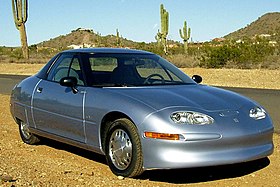GM EV1
| General Motors EV1 | |
|---|---|
 |
|
| Overview | |
| Manufacturer | General Motors |
| Also called | GM EV1 |
| Production | 1996–1999 (1,117 units) 1997 Model Year: 660 Gen I units 1999 Model Year: 457 Gen II units |
| Assembly | GM Lansing Craft Centre, Lansing, Michigan, United States |
| Body and chassis | |
| Class | Electric subcompact coupé |
| Body style | 2-seat, 2-door coupé |
| Layout | Transverse front-motor, front-wheel drive |
| Powertrain | |
| Electric motor |
three-phase Alternating current Induction motor with IGBT power inverter 137 bhp (102 kW) at 7000 rpm 110 lb·ft (149 N·m) at 0–7000 rpm |
| Transmission | Single-speed reduction integrated with motor and differential |
| Battery | Early vehicles 16.5–18.7 kWh lead-acid, later versions 26.4 kWh Nickel Metal Hydride (NiMH) |
| Plug-in charging | 6.6 kW Magne Charge inductive converter |
| Dimensions | |
| Wheelbase | 98.9 in (2,512 mm) |
| Length | 169.7 in (4,310 mm) |
| Width | 69.5 in (1,765 mm) |
| Height | 50.5 in (1,283 mm) |
| Curb weight | 3,086 lb (1,400 kg) with Lead-acid batteries 2,908 lb (1,319 kg) with NiMH batteries |
| Chronology | |
| Predecessor | GM Impact (prototype) |
| Successor | |
The General Motors EV1 was an electric car produced and leased by General Motors from 1996 to 1999. It was the first mass-produced and purpose-designed electric vehicle of the modern era from a major automaker, the first GM car designed to be an electric vehicle from the outset along with being the first and only passenger car to be sold under the corporate General Motors (GM) name instead of being branded under one of its divisions.
The decision to mass-produce an electric car came after GM received a favorable reception for its 1990 Impact electric concept car, upon which the design of the EV1 drew heavily. Inspired partly by the Impact's perceived potential for success, the California Air Resources Board (CARB) subsequently passed a mandate that made the production and sale of zero-emissions vehicles (ZEV) a requirement for the seven major automakers selling cars in the United States to continue to market their vehicles in California. The EV1 was made available through limited lease-only agreements, initially to residents of the cities of Los Angeles, California, and Phoenix and Tucson, Arizona. EV1 lessees were officially participants in a "real-world engineering evaluation" and market study into the feasibility of producing and marketing a commuter electric vehicle in select U.S. markets undertaken by GM's Advanced Technology Vehicles group. The cars were not available for purchase, and could be serviced only at designated Saturn dealerships. Within a year of the EV1's release, leasing programs were also launched in San Francisco and Sacramento, California, along with a limited program in the state of Georgia.
...
Wikipedia
